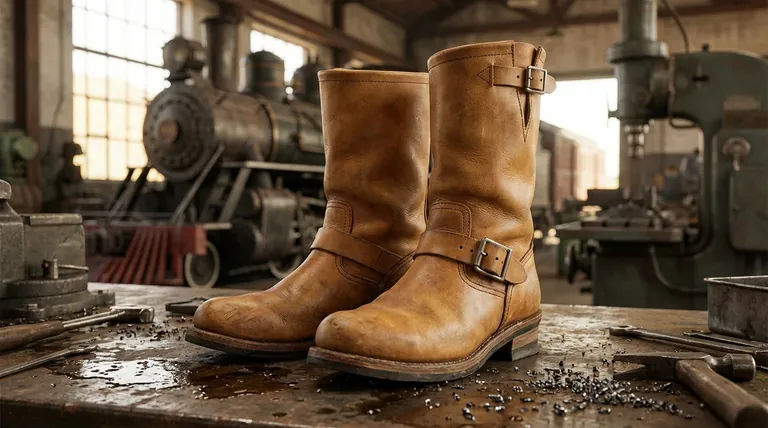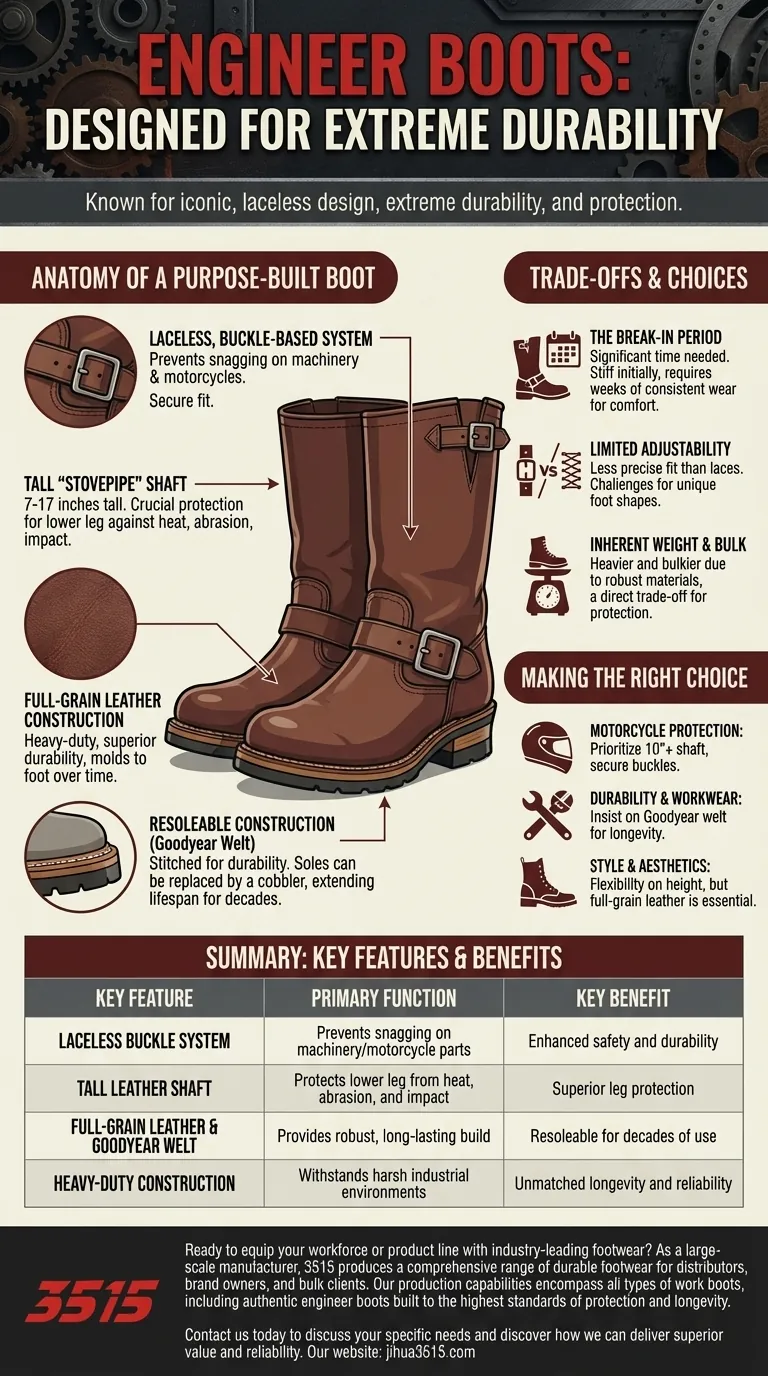Engineer boots are known for their iconic, laceless design that prioritizes extreme durability and protection. They are defined by a tall leather shaft, a rounded toe, and adjustable buckle straps at the ankle and top, a direct result of their origins as safety equipment for industrial workers and their later adoption by motorcyclists.
At their core, engineer boots represent a design philosophy where rugged function dictates form. Their most recognizable features—the absence of laces and the heavy-duty buckle system—are not stylistic choices but deliberate solutions for demanding environments where snags and impacts are a constant risk.

The Anatomy of a Purpose-Built Boot
The design of an engineer boot is a masterclass in functional simplicity. Every component serves a distinct purpose rooted in protection and longevity, explaining why the style has changed so little over the decades.
The Laceless, Buckle-Based System
The most defining feature is the complete absence of laces. This was a critical safety innovation for their original wearers, steam locomotive engineers, as it eliminated the risk of laces getting caught in moving machinery.
Motorcyclists adopted the style for the same reason—laces can become entangled in a bike's controls or chain. Instead, an adjustable leather strap and metal buckle cross the instep to secure the foot, with another buckle at the top of the shaft to customize the fit around the calf.
The Tall "Stovepipe" Shaft
Engineer boots feature a tall, unstructured shaft, often called a "stovepipe," that typically ranges from 7 to 17 inches. This provides crucial protection for the lower leg against heat, abrasion, debris, or impact.
Full-Grain Leather Construction
These boots are almost exclusively built from heavy-duty, full-grain leather, which is prized for its superior durability and resistance to wear. The leather is often oiled, which increases its flexibility and water resistance. Over time, this robust material molds to the wearer's foot for a custom fit.
The Foundation: Resoleable Construction
High-quality engineer boots are built using traditional methods like Goodyear welting or stitch-down construction. This stitching technique attaches the upper to the sole in a way that creates a highly durable and water-resistant seal.
Crucially, this construction method makes the boots resoleable. This means a worn-out sole can be replaced by a cobbler, dramatically extending the boot's functional lifespan for decades. The outsoles themselves are typically thick rubber or neoprene, chosen for their oil resistance and grip.
Understanding the Trade-offs
While exceptionally capable, the design of engineer boots comes with inherent compromises that are important to understand.
The Break-In Period
The same thick, full-grain leather that provides incredible protection also requires a significant break-in period. The boots can feel stiff and unforgiving at first, only achieving true comfort after weeks of consistent wear as the leather softens and conforms to your foot.
Limited Adjustability
A buckle system, while secure, offers far less point-specific adjustability than a traditional lacing system. Wearers with uniquely shaped feet or high insteps may find it more difficult to achieve a perfect, fine-tuned fit.
Inherent Weight and Bulk
The focus on durability means using heavy leather, thick soles, and metal hardware. As a result, engineer boots are heavier and bulkier than most other footwear styles. This is a direct trade-off for their protective qualities.
Making the Right Choice for Your Goal
Selecting the right engineer boot depends entirely on your primary intended use.
- If your primary focus is motorcycle protection: Prioritize a taller shaft (at least 10 inches), robust construction, and a secure ankle buckle to ensure the boot will not come off in an accident.
- If your primary focus is durability and workwear: Insist on a Goodyear welt or stitch-down construction, as this is the single most important feature for long-term use and repairability.
- If your primary focus is style and aesthetics: You have more flexibility on shaft height and sole type, but sticking with full-grain leather is essential for achieving the authentic look and feel.
By understanding the purpose behind each element, you can appreciate the engineer boot as a timeless piece of functional design.
Summary Table:
| Key Feature | Primary Function | Key Benefit |
|---|---|---|
| Laceless Buckle System | Prevents snagging on machinery/motorcycle parts | Enhanced safety and durability |
| Tall Leather Shaft | Protects lower leg from heat, abrasion, and impact | Superior leg protection |
| Full-Grain Leather & Goodyear Welt | Provides robust, long-lasting build | Resoleable for decades of use |
| Heavy-Duty Construction | Withstands harsh industrial environments | Unmatched longevity and reliability |
Ready to equip your workforce or product line with industry-leading footwear?
As a large-scale manufacturer, 3515 produces a comprehensive range of durable footwear for distributors, brand owners, and bulk clients. Our production capabilities encompass all types of work boots, including authentic engineer boots built to the highest standards of protection and longevity.
Contact us today to discuss your specific needs and discover how we can deliver superior value and reliability.
Visual Guide

Related Products
- Durable Goodyear Welt Leather Work Boots for Wholesale & Private Label
- Durable Leather Work Boots for Wholesale & Custom Manufacturing
- Durable Leather Work Boots Wholesale Manufacturer & Custom Factory
- Wholesale Durable Leather Work Boots | 8-Inch Goodyear Welt Manufacturer
- Durable Leather Work Boots for Wholesale & Custom OEM Manufacturing
People Also Ask
- Which material is the most durable for work boots? Find the Right Boot for Your Job
- Which brands are known for high-quality work boots? A Guide to Durable, Safe Footwear
- Is it normal to wear shoes in the house? A Guide to Hygiene, Comfort & Culture
- What cultural and environmental considerations are tied to wearing shoes indoors? Balance Hygiene, Tradition, and Foot Health
- What are the cultural perspectives on wearing shoes in the house? A Guide to Home Etiquette & Hygiene



















